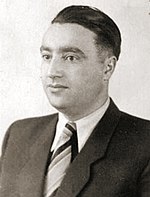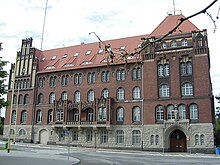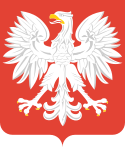Ministry of Public Security (Poland)

The Ministry of Public Security (
The initial UB was headed by Public Security General
The Ministry of Public Security was established on 1 January 1945 and ceased operations on 7 December 1954. It was the chief secret service in communist Poland during the period of Stalinism. Throughout its existence, the UB was responsible for brutally beating, arresting, imprisoning, torturing and murdering at least tens of thousands[3][4] of political opponents and suspects as well as taking part in actions such as Operation Vistula in 1947. The headquarters were located on Koszykowa Street in central Warsaw, but its branches and places of detention were scattered across the entire country, the most infamous being Mokotów Prison.
The Department of Security was replaced by a short-lived Committee for Public Security (1954–1956) and then by a marginally less repressive Security Service (SB) in 1956. All secret servicemen, functionaries, and employees were widely known by the public as Ubecy; in English "Ubeks" and singular "Ubek/Esbek" (pronounced: OO-beck).
History
In July 1944, behind the Soviet front line, a brand new Polish provisional government was formed, called the Polish Committee of National Liberation (Polski Komitet Wyzwolenia Narodowego, PKWN).[5] It was established in Chełm on the initiative of Polish communists, in order to assume control over Polish territories liberated from Nazi Germany by the advancing Red Army. PKWN was proclaimed "the only legitimate Polish government" by Stalin, with full political control and Soviet sponsorship. Within the PKWN's internal structure, there were thirteen departments called Resorty. One of these was the Department of Public Security (Resort Bezpieczeństwa Publicznego) or RBP, headed by Stanisław Radkiewicz. It was a precursor of the Polish communist secret police.[6][7]
On 31 December 1944, the PKWN was joined by several members of the London-based
UB tasks and numbers
From the end of the 1940s to 1954, the Ministry of Public Security – operating alongside the
In 1950s Ministry of Public Security employed around 32,000 people. Also, UB had control over 41,000 soldiers, including 29,053 privates and 2,356 officers of the Internal Security Corps (Korpus Bezpieczeństwa Wewnętrznego, KBW),[8] 57,000 officers in the Citizens' Militia (Milicja Obywatelska), 32,000 officers and soldiers in the Border guard (Wojska Ochrony Pogranicza), 10,000 prison officers (Straż Więzienna), and 125,000 members of Volunteer Reserves of the Citizens Militia (Ochotnicza Rezerwa Milicji Obywatelskiej, ORMO), a paramilitary police used for special operations.[6]
Soviet infiltration and political repressions
Political penetration and military control over the country by the
The first Russian chief advisor to the MPB was
The Stalinist reign of terror
Infiltrated by NKGB and NKVD agents – the Ministry of Public Security was well known for its
Overall, in the years 1944–1956 around 300,000 Polish citizens had been arrested, of whom many thousands were sentenced to long-term imprisonment. There were 6,000 death sentences pronounced, the majority of them carried out "in the majesty of the law". A special disciplinary legislation had been introduced, which allowed for the sentencing of civil persons before military tribunals including young people and children.
Defection


In November 1953,
The two officials traveled to Berlin and spoke with Mielke. On December 5, 1953, the day after meeting Mielke, Światło defected to the United States through their military mission in West Berlin. The next day, American military authorities transported Światło to Frankfurt and by December, Światło had been flown to Washington D.C, where he underwent an extensive debriefing.[6]
Światło's defection was widely publicized in the United States and Europe by the American authorities, as well as in Poland via
Among other activities, Światło had been ordered to falsify evidence that was used to incriminate
Organization


The political and administrative matters of the Ministry came under the authority of Jakub Berman, a Stalinist from the Polish United Workers' Party. The Ministry of Public Security structure was being changed constantly from January 1945 on, as the Ministry expanded. It was divided into departments and each department was subdivided into sections entrusted with different tasks. In January 1945, the largest and the most important department in UB was Department One, responsible for counter-espionage and anti-state activities. It was headed by General Roman Romkowski. Department I was divided into Sections, each responsible for a different but specific function self-described in the following way:
- Fighting German espionage and Nazi underground remaining in Poland.
- Fighting reactionary underground.
- Fighting political banditry.
- Protection of the national economy.
- Protection of legal political parties from outside (underground) penetration.
- Prisons.
- Observation.
- Investigations.
Two new departments were formed in addition to departments and sections created for the Resort Bezpieczeństwa Publicznego (RBP) forming the core of MBP or UB in January 1945. On September 6, 1945, from the existing structure of Department II emerged three additional departments: Department IV commanded by Aleksander Wolski-Dyszko, Department V commanded by
In June 1948 the Secret Office was established for Internal counter-intelligence. The Special Office conducted surveillance on members of the MPB itself. On March 2, 1949, the Special Bureau was established, renamed in 1951 simply as Department Ten. Department 10 conducted surveillance of high-ranking members of the Polish United Workers' Party and people associated with them.[6]
Ministry of Public Security roster (1951 and 1953)

- Minister of Public Security – Gen. Stanisław Radkiewicz (1944/54)
- Deputy – Gen. Mieczysław Mietkowski (pl) (1944/54)
- Deputy – Col. Konrad Świetlik (pl) (1948/54)
- Deputy – Wacław Lewikowski (pl) (1949/52)
- Deputy – Gen. Roman Romkowski (1946/49)
- Deputy – Gen. Mieczysław Moczar (1948)
- Department I – Counter-intelligence – headed by Col. Stefan Antosiewicz (pl) (1944-48/54)
- Department II – Operative Technology and records – headed by Col. Leon Rubinstein (pl) (1947-49/51)
- Department III – Fighting "bandits" – headed by Col. Józef Czaplicki (b. Izydor Kurc, 1950/53)
- Department IV – Protection of economy – headed by Col. Józef Kratko
- Department V – Religious political and social organizations – headed by Col. Julia Brystiger (1954)
- Department VI – Prisons – headed by Col. Stanisław Pizło (1946-47/51)
- Department VII – Intelligence – headed by Col. Witold (Lewin) Sieniewicz (1950/54)
- Department of Investigations – headed by Col. Józef Różański (b.
Josef Goldberg) (1945/47)
- Department for Training – headed by Mjr. Zdzisław Szymczak (1945-48/53)
- Department of Staff – headed by Col. Mikołaj Orechwa (1944/54)
- Department for Government Protection – headed by Col. Faustym Grzybowski
- Department of Transport – headed by Col. Czesław Radzicki
- Department of Communications – headed by Col. Feliks Suczek
- Special Bureau – headed by Col. Anatol Fejgin (1950/53)
- Bureau for control – deputies: Joachim Getzel (1949), Jefim Artymowicz (1952/54)
- Bureau of foreign passports – headed by Lt. Col. Władyslaw (Spychaj) Sobczyński
- Bureau of Budget and Finances – headed by Lt./Lt. Col. Szymon Ela Tenenbaum
- Bureau A (Observation of suspicious element)
- Bureau B (Central archives) – headed by Col. Zygmunt Okręt
UB in the field

All over Poland Ministry of Public Security had regional offices. There was one, or more UB office in each voivodeship, each of them called the Voivode Office of Public Security (Wojewódzki Urząd Bezpieczeństwa Publicznego, or WUBP). Each WUBP had 308 full-time UB officers and employees on staff. Beside WUBP, there were also City Offices of Public Security (Miejski Urząd Bezpieczeństwa Publicznego or MUBP), with 148 MPB officers and employees; as well as District Offices of Public Security (Powiatowy Urząd Bezpieczeństwa Publicznego or PUBP), with 51 officers and employees; and finally, the Communal Offices of Public Security (Gminny Urząd Bezpieczeństwa Publicznego, or GUBP), which were stationed at the local militia precincts (MO), with 3 UBP security officers on staff.[6]
In 1953, in the field, there were 17 Voivode Offices of Public Security (WUBP), and 2 Regional Offices of Public Security on the order of WUBP. There were 268 District Offices of Public Security (PUBP) and 5 City Offices of Public Security (MUBP), which operated as District Offices of Public Security (PUBP). Together, they employed 33,200 permanent officers, of which 7,500 were stationed in their
1954 reorganization and formation of SB

The highly publicized defection of Colonel Światło, not to mention the general hatred of the Ministry of Public Security among the Polish public led to changes in late 1954. In December of that year, the
The Committee for Public Security took responsibility for
Notable MBP and UB personnel
|
|
Notable people killed by the MBP and UB
In Warsaw, most of the killings were carried out at the Mokotów Prison. The victims' bodies – often placed naked in cement bags – were wheeled out at night and buried in unmarked graves in the vicinity of various Warsaw cemeteries and in open fields.[citation needed]
|
|
See also
- Montelupich prison
- Milicja Obywatelska (MO)
- Zgoda labour camp, a concentration camp for Silesians, Germans, and Poles, operated in 1945 by the Polish secret police
References
- ISBN 9780786403714– via Google Books.
- ^ Polish Secret Police, The "Bezpieka": Dossiers of Polish secret police functionaries. DoomedSoldiers.com. Retrieved June 3, 2012.
- ISBN 9788391591819– via Google Books.
- )
- ISBN 0-231-05351-7.
- ^ ISBN 83-89078-94-5. Archived(PDF) from the original on January 4, 2012. Retrieved June 3, 2012.
- ^ ISBN 978-83-60464-80-9. Archived from the original(PDF) on October 29, 2013. Retrieved May 31, 2012.
- )
- ^ God's Playground: 1795 to the present By Norman Davies (in English)
- ^ Since Stalin, a photo history of our time by Boris Shub and Bernard Quint, Swen Publications, New York, Manila, 1951. Page 121.
- ^ ISBN 978-0-300-12198-8. Retrieved May 24, 2011.
puppet government they had set up formally disbanded the AK.
- ^ a b Civil war in Poland. Europe since 1945: an encyclopedia, Volume 2, Bernard A. Cook (in English)
- ISBN 0-7864-2913-5.
- Instytut Pamięci Narodowej. Archived from the originalon September 30, 2012. Retrieved June 1, 2011.
- ^ Bates, John (2000). "Stalinism in Poland: 1945-1956". arts.gla.ac.uk. Archived from the original on 2005-12-19.
- ^ "Doomed Soldiers, About - This Project Is An All Volunteer Effort Dedicated To the Preservation of history of the fallen Polish Underground Soldiers From Home Army (Armia Krajowa), WiN (Wolnosc i Niezawislosc), NSZ (Narodowe Sily Zbrojne), ROAK, And Other Patriotic Polish Underground Organizations". www.doomedsoldiers.com.
- ISBN 978-83-01-14487-6.
Bibliography
- Leszek Pawlikowicz, Tajny Front Zimnej Wojny: Uciekinierzy z polskich służb specjalnych 1956–1964, Oficyna Wydawnicza RYTM, 2004, 1st edition
- Henryk Piecuch, Akcje Specjalne: Od Bieruta do Ochaba, (part of a series: Tajna Historia Polski, Agencja Wydawnicza CB, Warsaw, 1996 (English: Special Operations: from Bierut to Ochab, Secret History of Poland series, Warsaw 1996)
- Nigel West, Trzecia Tajemnica: Kulisy zamachu na Papieża (English: The Third Secret, Behind the Assacination Attempt on the Pope), publ. in Sensacje XX Wieku
- Metody Pracy Operacyjnej Aparatu Bezpieczństwa wobec kościołów i związków zawodowych 1945–1989, IPN, Warsaw, 2004 (Methods of operative work of Security organs against churches and trade unions 1945–1989, published by Institute of National Remembrance)
- Normam Polmar, Thomas Allen – Księga Szpiegów (The Book of Spies), Wydawnictwo Magnum, Warsaw, 2000
- Zbigniew Błażyński, Mówi Józef Światło: Za kulisami bezpieki i partii 1940–1955, Warsaw 2003
- Jusupović, Adrian; Leśkiewicz, Rafa (2013). Historyczno-prawna analiza struktur organów bezpieczeństwa państwa w Polsce Ludowej (1944-1990). Zbiór studiów. Warsaw: Instytut Pamięci Narodowej. Komisja Ścigania Zbrodni przeciwko Narodowi Polskiemu. ISBN 978-83-7629-457-5.
External links and further reading
- List of persons condemned by Military Courts to the capital punishment (1946–1955)
- Henryk Piecuch, Brudne gry: ostatnie akcje Służb Specjalnych (seria: Tajna Historia Polski) (Dirty Games: the Last Special Services Operations [Secret History of Poland series]). Warsaw: Agencja Wydawnicza CB (1998).
| International | |
|---|---|
| National | |
| Other | |

